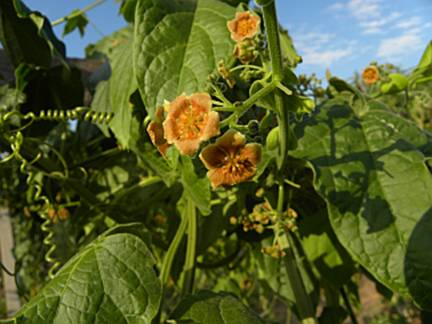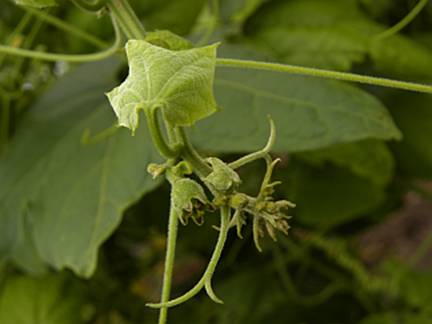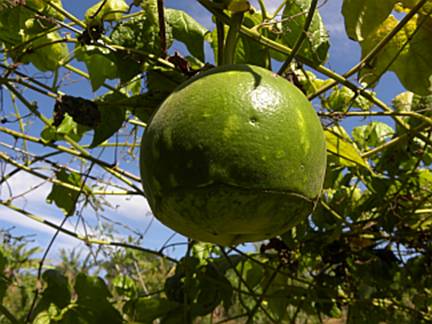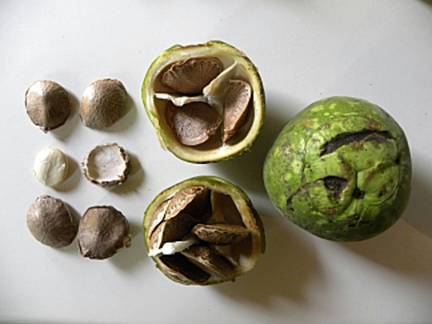FEVILLEA PASSIFLORA
FAMILY OF CUCURBITACEAE
|
|
|
|
Male flowers |
Female flowers |
|
|
|
|
Green fruits |
Fruits and seeds |
NOMEMCLATURE AND SIGNIFIANCE: GUINDIROBA comes from the Tupi Guaraini and means "bitter oil" alluded to the seeds that produce this oil. Also named as Cipó Jabota and Gasoline Fruit.
Origin: Rare species, occurs at several places in the Atlantic Forest and the semi-evergreen deciduous forest, always near or at the forest edges. Occurs from Bahia to Santa Catarina in Brazil. More information in the Portuguese language at the link: http://floradobrasil.jbrj.gov.br/2012/index?mode=sv&group=Root_.Angiospermas_&family=Root_.Angiospermas_.Cucurbitaceae_AJUS&genus=Fevillea&species=&author=&common=&occurs=1®ion=&state=&phyto=&endemic=&origin=&vegetation=&last_level=subspecies&listopt=1
Features: Perennial climbing plant with velvety shoots when they are young, older shoots are bare. The leaves are available individually or with wavy wells, heart-shaped and based glandular and with a rounded tip. The leaf is of a delicate texture, has three prominent ridges on the back, is 8 to 14 cm long and 5 to 9 cm wide. The male flowers are in panicles (collar type) axililar with 20 to 50 staminate flowers, which are brownish orange. The female flowers appear singly or in pairs at the base of the petioles. They have 5 petals and 5 sepals at the surface with a stamp. The fruit is a capsule with a diameter of 7 to 12 cm, contains large, oily and disk-shaped seeds with a hard shell.
Culture tips: Fast-growing vine that can withstand temperatures down to -3°C and is also resistant to drought. Grows well in different altitudes of 400 to 1000 m above sea level. The soil should be deep, and be moist with sandy or loamy texture (red soil). At least 3 plants should be planted, as it could be one or two female and bear fruit. A trellis with horizontal wires or crossed rafters should be built. At intervals of 40 cm between the wires, which should be applied upright. The plants begin in the first year after planting to bear fruit.
Propagation: The seeds are round and flat, with a very hard shell or envelope. To germinate, the shell must be carefully opened with a stick on the corners, then take out the core and individually planted in pots with rich organic matter and porous substrate in the shade. Germination takes 40-70 days at a low percentage. The seedlings reach 50 cm after 6 months and can be planted in the age of one year to a permanent location. The best time to plant is during the months from October to December. It is best to be done by the proliferation mature cuttings with 1 to 2 leaves.
Planting: Can be planted between large trees by a large margin in full sun and in the shade of the woods, but this situation delays the formation of the fruit. The distance should be between the plants 4 x 4 m. The trellis should be 6 bits at intervals of 2 meters and 3 meters between the pairs and have to be 1.80 m high, to facilitate harvesting. Work100 g lime and 8 kg of organic material in.
Culture: Trimming and removal of the shoots from the base of the trunk, the shoots on a trellis attached so they do not fall down. After the plant has grown up, prune and thin out the fruit. Thin out the branches of the male plant which does not bear fruit. Fertilize with organic compost, it can be 4 kg poultry manure well mixed with 30 g of NPK 10-10-10, distributed in the months of November and December, at a distance of 30 cm from the trunk. Mulch the base with dead matter to retain moisture.
Use: Bear fruit in the months from October to January. The fruits are not edible, but their seeds produce high quality vegetable oil, known in 70% yield. A tea made from the seeds can help against diarrhea. The oil has a high burning energy and therefore has great potential as a vegetal biodiesel fuel. The plant is threatened with extinction, should therefore be planted in order to be saved from extinction.
Back to the seedlist (English) or back to Cucurbitaceae (Portuguese)



